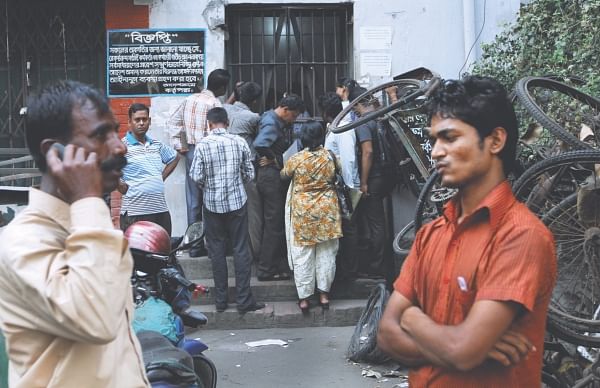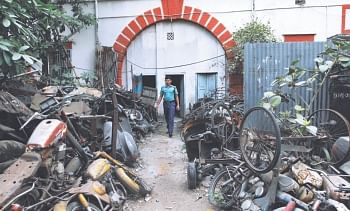| Home - Back Issues - The Team - Contact Us |
 |
| Volume 11 |Issue 14| April 06, 2012 | |
|
|
Perspective
The Collapsing Lower Court Akram Hosen Mamun At first sight, the lower courts of Dhaka, in Sadarghat appear to be a space where time stands still. Under the glare of a hot, brooding summer sun people sit on the spacious platforms of the large courtyard. From the manner or their motionless, passive and languorous posture, one gets the impression that the time we measure with clocks doesn't amount to much in this place. In the heavy afternoon air, men smoke ceaselessly and throw cigarette stubs, ashes, and packs everywhere. Some people, mostly women and children who can't afford to eat at the shabby restaurants in the courtyard, sit on the stairs in groups and eat rice and curry they have brought from home. In the courtyard, there are some sheuli, segun,boroi, banyan, mango and star fruit trees with startlingly bright leaves that make the hot afternoon endurable to the people. The CMM Court and the judge court have old-fashioned and almost quaint buildings. In the dimly lit corners of the large pillars, arches, and ceilings, cobwebs have become so thick with dust that they keep falling on the floor. The place reminds one of the ugly, incommodious offices in Dickensian novels. "At present we have nobody to clean the building or the premises," says Ubaidul Karim Akhonda, a Najir (administrative official), Mahanagar Daera Judge Court. He informed that the six-storied building of Mahanagar Daera Judge Court was established in 1999. "When we started using this building we had a couple of sweepers who worked for Tk 80 per day. But none of them have come to the court in the last five years," he adds. The higher authorities have been repeatedly informed about the scarcity of cleaners and sweepers in CMM and lower court, but no initiative was taken to solve the problem. Karim also adds that the Mahanagar Daera Judge has informed the Minister of Law about the situation in the lower court. "Moreover, the former chief justice has informed the honourable president about the matter," he says. But nothing has changed. Appointment of new workers in the government offices is known to be a lengthy process. On conditions of anonymity, a judge of the lower court describes the appointment procedure, "We inform the Ministry of Law about the need for cleaners. Then the file goes to the Ministry of Establishment, from the Establishment, it then goes to the Ministry of Finance for approval."
However, in the lower court premises and corridors, a couple of people are seen to be collecting plastic bottles and sweeping floors on week days. "I sweep the corridors, collect plastic bottles from the courtrooms, clean the corners, and wash teacups and plates used by the officials," says Maleka, who is not an employee of the building. But she does all the work in the hopes of getting tips from the officials. "Moreover, I think it is better to work here than to beg on the streets," she concludes. However, when she was asked to explain why the place was so filthy, she says, "We do whatever we can. But if they want it cleaner, they will need to pay us regularly and hire a larger workforce." The people who clean the premises now live in the neighbourhood. The officials ask them to do the job. About their substandard work, Karim says, "Since they don't have a fixed salary for doing the job, their work do not become satisfactory." Due to lack of cleaners and sweepers, the toilets in the building are in appalling conditions. The stench of human waste turns one's stomach from a long way off. The old-fashioned buildings are taller than the contemporary ones. For elderly people, climbing the stairs to the sixth floor often becomes quite a challenge. A judge of the Special Judge Court, Dhaka says, "A lift has been defunct for the last six months. The one that is functioning now also remains closed in most of the days." He laments that he has to risk his health when he climbs the stairs of the buildings. He also informs that people often get stuck in the lifts when the electricity goes off. There is only one lift operator in the building, which does not have any backup power supply. In front of that building, a Toyota Estate is sinking slowly to the ground. There are also the carcasses of a truck, some motor bikes and rickshaws--all piled together and sinking into the ground. Many more discarded vehicles, engine blocks and huge crankshafts can be seen from the corridors. The spacious corridors are not without signs of decay: huge shelves and cabinets-- both wooden and metal-- are rotting in the corridors exuding a damp and grimy smell. On one side of the first floor corridor piles of files, deeds and papers bound in red tape has reached the ceiling; there are sacks full of weathered papers, lying on the floor beside boxes of snacks from bakeries. It is apparent that the authority is waiting in utter resignation for these obnoxious objects to vanish into thin air. A magistrate reluctant to give his name says that the cars and bikes were confiscated by the court over the decades. "Nobody has the authority to move the vehicles from the yard, until the cases against the owners are disposed by the court." He also adds that no major renovation of the buildings has been conducted in the last decade. Ironically enough, at the end of the long corridor, above the landing of a staircase, a wooden signboard reads, “Parishkar Paricchhannata Imaner Anga” (Cleanliness is integral to faith). During the proceedings, the accused sometimes crouch on the dusty floors. Some courtrooms even have monstrous iron cages for them. They are taken in and out of the buildings by policemen who hold ropes tied to their waist and feet. "This practice is reminiscent of the British colonial era. Although there have been occasional criticisms of tying the accused like that, no one has taken an initiative to change these practices," observes the magistrate. Everyday the lower court sees the largest gathering of lawyers in the country. "Quantitatively speaking, Dhaka Bar Association is the largest bar in Asia," says Md. Abul Khair, an Advocate. He also adds that of the 24,000 lawyers of the country, some 14,000 belong to Dhaka Bar. Nevertheless, in the lower court premises, there is only one hall room for the advocates and their clients. Khair complains, "There is no convenient space in the court premises to discuss the cases with our clients." He also adds that the construction of a building for the lawyers is underway. He hopes that after completion of the building, the lawyers will have a place to sit. During the office hours, the accused gets locked in a building behind the lower court. The cells are characterised by their gloom and incommodiousness. The detainees' friends and families swarm in front of the gate looking anxious. Some of them--all on conditions of anonymity--inform that they have come to see their dear ones. "I brought food from home to give my son. By giving a tip to the security guards, I can send the food to him," says a woman who has come from Uttara. She wishes that the court premises had cleaner toilets and the rooms in which the detainees are kept were cleaner. Coming back to the infrastructure of these important offices, it is evident that the offices need cleaners and sweepers immediately. At present, the scale of sheer negligence of the authority to these important public offices is beyond belief.
|
||||
|

